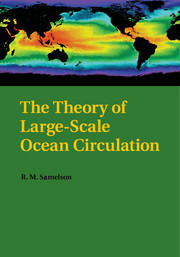Book contents
- Frontmatter
- Contents
- Preface
- 1 Basic Physical Principles and Equations
- 2 Reduced Equations for Large-Scale Motion
- 3 Planetary Geostrophic Vorticity Dynamics
- 4 Stratified Large-Scale Flow
- 5 Circulation in a Simple Rectangular Basin
- 6 Eddy-Driven Subsurface Motion
- 7 Circumpolar Flow
- 8 Mid-Depth Meridional Overturning
- 9 Thermohaline Effects
- 10 Theory and Observation
- Exercises
- References
- Index
5 - Circulation in a Simple Rectangular Basin
Published online by Cambridge University Press: 07 October 2011
- Frontmatter
- Contents
- Preface
- 1 Basic Physical Principles and Equations
- 2 Reduced Equations for Large-Scale Motion
- 3 Planetary Geostrophic Vorticity Dynamics
- 4 Stratified Large-Scale Flow
- 5 Circulation in a Simple Rectangular Basin
- 6 Eddy-Driven Subsurface Motion
- 7 Circumpolar Flow
- 8 Mid-Depth Meridional Overturning
- 9 Thermohaline Effects
- 10 Theory and Observation
- Exercises
- References
- Index
Summary
Domain and Boundary Conditions
With the basic large-scale-approximate equations and some of their general properties established, it is appropriate now to examine the circulation and thermocline structures that arise in specific solutions of these equations. Even for the simplest case of steady solutions, in which the flow is independent of time, this requires that a sufficient set of boundary conditions be specified. This set of boundary conditions is not unique: a variety of such conditions, which differ in physical and mathematical detail, may yield solutions of physical interest for the large-scale flow. In general, these sets of conditions for idealized models of ocean gyre structure and circulation must be chosen to represent the definitive characteristics of the general physical setting in which these large-scale features develop.
A fundamental element of the boundary conditions is the geometry specified for the ocean basin. The simplest such basin is a rectangular domain, restricted to a portion of one hemisphere, with vertical sidewalls aligned along lines of constant longitude x = {xW, xE} and latitude y = {yS, YN} and a flat bottom at the constant depth z = -H0 (Figure 5.1). Such a choice avoids the singularity of the planetary geostrophic momentum equations that arises at the equator, where the Coriolis parameter f vanishes. It also removes a complicating geometric element: the circumpolar connection that exists around the Antarctic continent in the southern hemisphere, which will be seen (Chapters 7 and 8) to have significant impact on the surface and mid-depth circulation.
- Type
- Chapter
- Information
- The Theory of Large-Scale Ocean Circulation , pp. 69 - 98Publisher: Cambridge University PressPrint publication year: 2011



